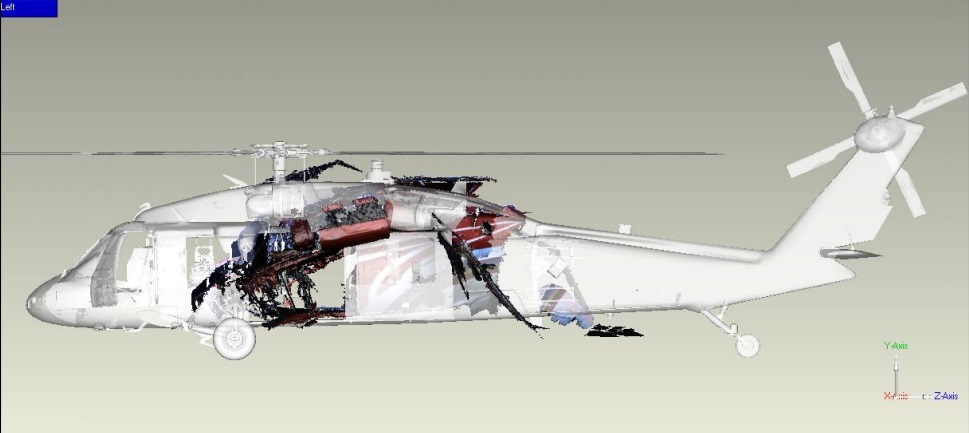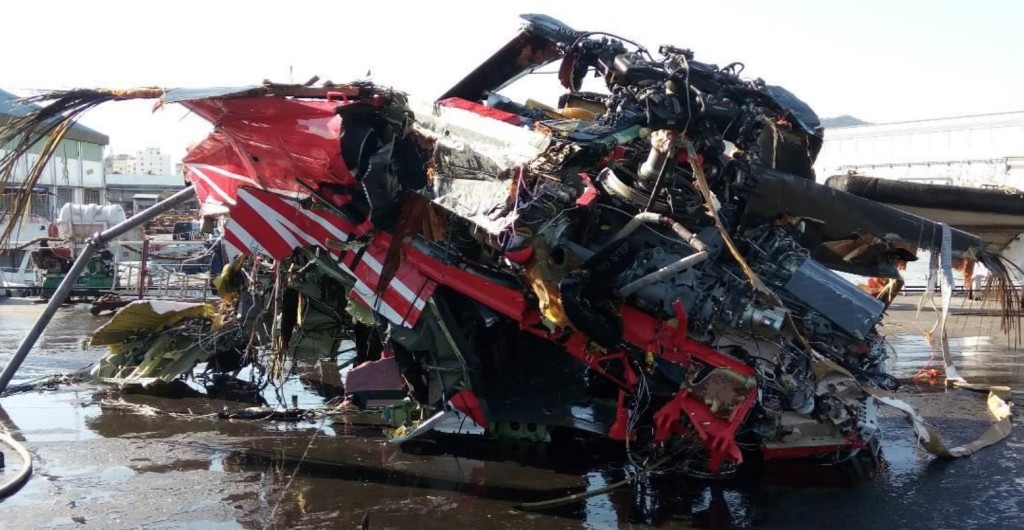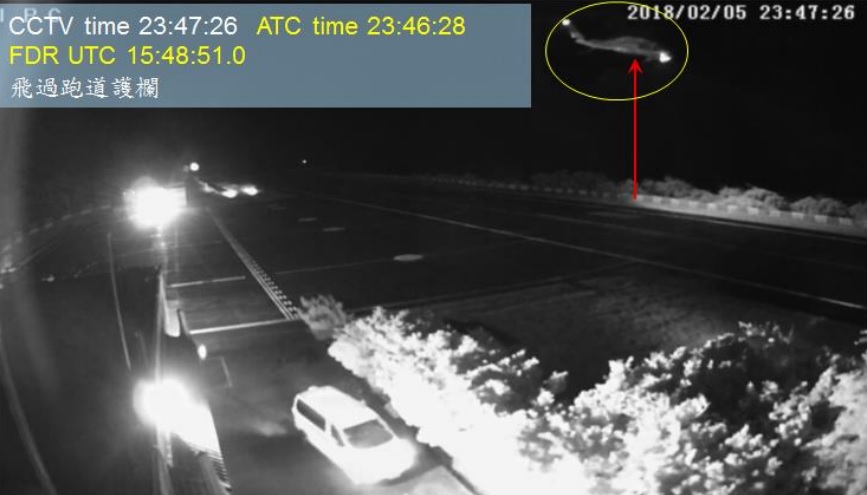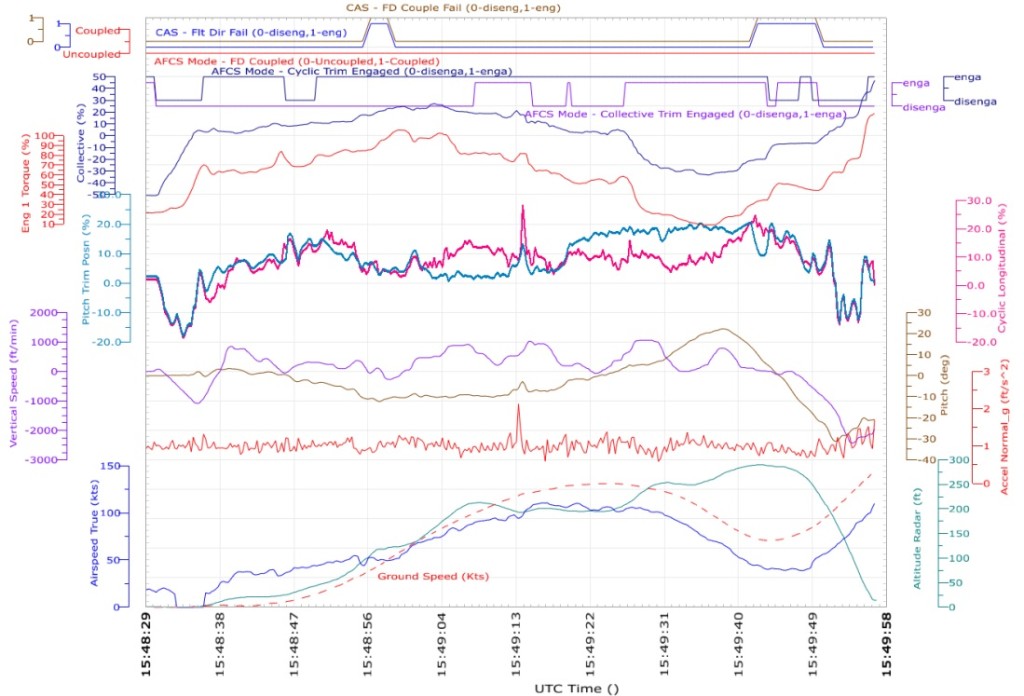Taiwan Night Medevac Helicopter Take Off Accident (NASC UH-60M Black Hawk NA-706)
On 5 February 2018 Sikorsky UH-60M Black Hawk helicopter NA-706 of the Taiwanese Ministry of the Interior National Airborne Service Corps (NASC), conducting a nighttime air ambulance medevac flight, departed Lanyu Airport on Orchid Island off the South East coast of Taiwan.
Contact was lost with the helicopter approximately 81 seconds after take off as it crashed into the sea. The 6 persons on board (two flight crew, one rear crew, a medical passenger, the patient and a family member) were killed.
History of the Accident Flight
In their safety investigation report (issued on 24 September 2019 and only available in full in Chinese) the Taiwan Transportation Safety Board (TTSB), which recently replaced the Aviation Safety Council (ASC) of Taiwan, explain that the aircraft had displayed ‘FD COUPLE FAIL’ and ‘FLT DIR FAIL’ warning captions on the outbound flight to Lanyu. The crew did not discuss these and they extinguished before landing (at 23:38 LT). The crew did a briefing on the take off during a quick turnaround, departing at 23:48 LT.
The environment featured ‘black-hole’ conditions. These conditions “typically occur over water or over dark, featureless terrain where the only visual stimuli are lights located on and/or near the airport or landing zone”. They are conducive to spatial disorientation.
The ‘FD COUPLE FAIL’ and ‘FLT DIR FAIL’ warnings briefly reappeared about 19 seconds into the flight and again were not discussed before they extinguished again after 3 seconds. It appears (based on our translation from Chinese) that an airspeed hold autopilot mode was engaged. The aircraft was now climbing at around 95 knots. The helicopter encountered an increasing tailwind about 23 seconds after taking off, that reached 40 knots. The crew mention windshear and turbulence. It appears the autopilot dropped out in the turbulence but the Pilot Monitoring commented “Now is a positive rate of climb, it doesn’t matter”. However, the TTSB state that while the aircraft was now at 197 ft and 106 knots 44 seconds after take off, the rate of climb had dropped to 192 ft/min.
Furthermore the nose starts to pitch up (peaking at 22.2º), speed decreases and climb rate slows and then the aircraft starts to descend. At 78 seconds after take off the aircraft is at 133 ft but the rate of descent is now 2.100 ft/min. Moments after the CVR/FDR stop recording.

NASC Sikorsky UH-60M NA-706 Flight Path (Credit: Lanyu Airport Airport CCTV annotated by Taiwan TSB)
The aircraft impacted water that was 1000m deep.

Digital Reconstruction of the Wreckage of NASC Sikorsky UH-60M NA-706 Recovered (Credit: via Taiwan TSB)
The aircraft was not equipped with an Emergency Flotation System (EFS).
TTSB Analysis
The TTSB note that the NASC “do not provide the complete Standard Operating Procedures (SOPs)” nor did the flight crew totally follow the SOPs that were in place. Additionally:
The NASC failed to plan the appropriate training of the flight crews. [Specifically they] did not properly arrange the training resources of the UH-60M aircraft, and did not plan the suitable ground course for the advanced models. [T]raining hours of the simulators were insufficient [too]. The NASC does not define the minimum requirements related to night flight and instrument flight time, has no specific complete training material for Crew Resource Management [CRM] training and and did not define the weather standards for night EMS…
TTSB Conclusions
The TTSB conclude that:
The flight crew’s threat management, situation awareness, communication and decision-making capabilities as well as the understanding of the aircraft system were not sufficient. They did not choose the appropriate takeoff mode at takeoff under the night circumstance and unsteady wind condition.
During the take-off process, [the helicopter] failed to maintain a safe climbing attitude and speed, and in the event of turbulent flow, it was not possible to immediately interpret the aircraft attitude and maintain the control correctly, and may [have been] accompanied by the phenomenon of space disorientation.
Finally, when the Pilot Flying pitched down the aircraft at low altitude to correct the low airspeed, both of the flight crew were not paying attention to the low altitude, resulted in the aircraft controlled flight into the sea.
TTSB Safety Recommendations
The TTSB made 7 safety recommendations:
To the National Airborne Service Corps, Ministry of the Interior
- Enhance the training of flight crew in threat management, situation awareness, communication decision-making, and understanding of the aircraft system, and establish the requirements and standards for instrument flight and night flight training.
- Examine the integrity and training resources of the UH-60M aircraft flight crew training program to implement the training effectiveness of the flight crew.
- Review the consistency and integrity of the flight operation manual and mission procedures to facilitate the safety of related flight missions.
- Consider to define the weather standards for conducting the EMS mission at night and the necessity of the UH-60M standard operating procedures to facilitate related missions.
- Plan an appropriate crew resource management training material to facilitate the implementation of the flight mission.
- Review the correctness of related parameters recorded in IVHMS to facilitate the readiness of flight data [Note: Collective Trim and Yaw Trim was judged suspect by investigators].
To Civil Aeronautics Administration, Ministry of Transportation and Communications:
- Re-evaluate the demand for emergency medical service at night in Lanyu Airport and enhance the runway light identification and guidance functions. If the requirements for runway construction cannot be improved, the planning and operating procedures for the night mission should be strengthened.
Safety Resources
The TTSB refer to the Degraded Visual Environment (DVE) section of EHEST Leaflet HE 1 Safety Considerations:

Also relevant is EHEST Leaflet HE9 Automation and Flight Path Management
We have previously discussed these night accidents:
- HEMS Black Hole Accident: “Organisational, Regulatory and Oversight Deficiencies”
- Deadly Combination of Misloading and a Somatogravic Illusion: Alaskan Otter
- HEMS S-76C Night Approach LOC-I Incident a near accident in Canada
- Life Flight 6 – US HEMS Post Accident Review video and emergency response lessons from a US night accident
- More US Night HEMS Accidents
- Night Offshore Winching CFIT a German HEMS unit attempts night offshore winching
- Night Offshore Training AS365N3 Accident in India
- US Police Helicopter Night CFIT: Is Your Journey Really Necessary?
- Fatal Night-time UK AW139 Accident Highlights Business Aviation Safety Lessons
- US Fatal Night HEMS Accident: Self-Induced Pressure & Inadequate Oversight
- SAR Crew With High Workload Land Wheels Up on Beach
- Italian HEMS AW139 Inadvertent IMC Accident
- HEMS A109S Night Loss of Control Inflight
- UPDATE 30 November 2019: Fall From Stretcher During Taiwanese SAR Mission (NASC AS365N2 NA-104)
- UPDATE 14 December 2019: Fatal Taiwanese Night SAR Hoist Mission (NASC AS365N3 NA-106)
- UPDATE 21 December 2019: BK117B2 Air Ambulance Flameout: Fuel Transfer Pumps OFF, Caution Lights Invisible in NVG Modified Cockpit
- UPDATE 5 March 2020: HEMS AW109S Collided With Radio Mast During Night Flight
- UPDATE 19 April 2020: SAR Helicopter Loss of Control at Night: ATSB Report
- UPDATE 11 May 2020: European Search and Rescue (SAR) Competition Bonanza
- UPDATE 23 August 2020: NTSB Investigation into AW139 Bahamas Night Take Off Accident
- UPDATE 21 August 2021: Air Methods AS350B3 Night CFIT in Snow
- UPDATE 15 January 2022: Air Ambulance Helicopter Struck Ground During Go-Around after NVIS Inadvertent IMC Entry
- UPDATE 17 February 2024: Night Offshore Take-Off Loss of Control Incident
- UPDATE 18 February 2024: Night Offshore Helicopter Approach Water Impact
- UPDATE 13 July 2024: Fatal USCG SAR Training Flight: Inadvertent IMC
We have discussed helicopter automation previously:
- Technology Friend or Foe – Automation in Offshore Helicopter Operations
- Aerossurance Marks RAeS 150th Anniversary by Sponsoring Rotorcraft Automation Conference
Certain aspects of this flight are reminiscent of the Transportation Safety Board (TSB) of Canada report into a serious incident where Sikorsky S-92A C-GQCH where the helicopter descended to within 38ft of the sea on take off offshore. Another S-92A serious incident off Nova Scotia, which occurred on approach, is also now under investigation by TSB Canada:
On , a Sikorsky S-92 helicopter operated by Canadian Helicopters Offshore was conducting a flight between Stanfield/Halifax International airport (CYHZ) and the Thebaud gas field platform southwest of Sable Island, NS, with 2 crew and 11 passengers on board when it experienced a drop in altitude while approaching the platform. The helicopter pilots elected to return to CYHZ, where a landing was conducted without further incident. No injuries were reported.
UPDATE 8 May 2021: see Loss of Control, Twice, by Offshore Helicopter off Nova Scotia on that TSB final report.
We have also written about:
- Tail Rotor Pitch Control Loss During Hoisting: Fatal NASC Airbus Helicopters AS365N3 hoisting accident
- Hoist Assembly Errors: SAR Personnel Dropped Into Sea: NASC UH-60M hoist failure
SAR Consultancy: Procurement, Tenders, Contacts and In-Service Assurance and Aviation Advice
In September 2017 one European Coast Guard selected Aerossurance to be their new aviation consultants after a competitive tender with 7 bidders. In July 2018 Aerossurance started work supporting a second European Coast Guard with a procurement project. The Aerossurance team is and has supported humanitarian aid agencies, air ambulance charities, military air arms, environmental agencies and blue chip energy companies on other emergency service and special mission aviation projects around the world.
The Tender Trap: SAR and Medevac Contract Design: Aerossurance’s Andy Evans discusses how to set up clear and robust contracts for effective contracted SAR and HEMS operations.





Recent Comments